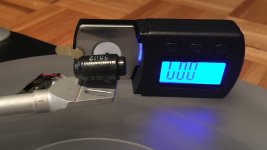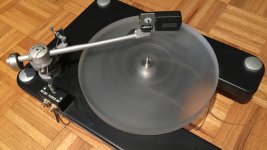Skate force originates in stylus-groove friction, and in modulation drag. Both of these elements are dynamic, ie vary with time, on a moment-to-moment basis. Friction can not only vary significantly in average level from record to record, but from moment to moment with a stick-slip flicker law. And so does skate force, of course, it can be all over the place as Bill says.
The industry seems to either ignore or be unaware of the effects of dynamic variation in skate force, but it is a major cause of unwanted tonearm motion, leading to pitch instability and other negative effects, IMO.
'Fixing' average skate force by the mechanisms available doesn't address this at all. What it does, geometrically, is generally improve balance of average forces on groove walls, the benefits of which are non-essential if the rig is tracking well at reasonable VTF, IMO.
I suspect that audible variation of adjusting anti-skate force might be due to changes to dynamic stylus-groove friction arising, ie tonearm/pitch stability, and as such isn't necessarily repeatable or consistent between rigs, records, or even locations on the record ?
But, perhaps counter-intuitively, the best antidote for the audible effects of dynamic skate force is tonearm damping, IMO. Once stability is ensured, classic anti-skate is non-essential, but might as well use whatever mechanism is there, IMO, so long as it doesn't introduce resonances etc etc.
Just my 2p worth.
LD
The industry seems to either ignore or be unaware of the effects of dynamic variation in skate force, but it is a major cause of unwanted tonearm motion, leading to pitch instability and other negative effects, IMO.
'Fixing' average skate force by the mechanisms available doesn't address this at all. What it does, geometrically, is generally improve balance of average forces on groove walls, the benefits of which are non-essential if the rig is tracking well at reasonable VTF, IMO.
I suspect that audible variation of adjusting anti-skate force might be due to changes to dynamic stylus-groove friction arising, ie tonearm/pitch stability, and as such isn't necessarily repeatable or consistent between rigs, records, or even locations on the record ?
But, perhaps counter-intuitively, the best antidote for the audible effects of dynamic skate force is tonearm damping, IMO. Once stability is ensured, classic anti-skate is non-essential, but might as well use whatever mechanism is there, IMO, so long as it doesn't introduce resonances etc etc.
Just my 2p worth.
LD
Thank you for this insight, it is good!.. the best antidote for the audible effects of dynamic skate force is tonearm damping, IMO.
Dual had a skate-o-meter. Don't know how accurate it is. Would be fun to own one.
I think it indeed is an accurate device. In the service manuals to their TT's, Dual adviced the technician only to use this, in combination with a specified test record, to calibrate the TT's skating compensation facility.
No, I don't own the Dual Skate-O-Meter, neither the appropriate test record, but I think I should, 'cause I'm servicing vintage Dual disc changers since some few years.
Best regards!
Last edited:
I always used Test LP to adjust anti skating before I built my air bearing arms, but I have been thinking of using jewelry scale to measure anti skating force for long time.
This method of anti skating measurement is based upon following principal. Anti skating force should be almost same as VTF.
The arm I used was VPI’s. It has no anti skating device. The only thing I could do was to twist the signal wire to get some resistant force. I have Graham 2.2 arm, too. Graham has very nice anti skating device. However, I broke the arm tube.
First, I added a weight which was 13 g on the head shell and adjusted the counter weight until the head shell suspended in the air. In reality, you don't need to add weight. I added weight just for the experiment. Care should be taken not to damage your cartridge. The height of head shell should be about same as the height of actual cartridge. Then, I put the scale on its side. I have three jewelry scales. This kind of scale doesn’t change its reading when you put it on its side. In order to let the scale to set to zero, I put the scale on its side first, then to turn it on. I twisted the signal wire to get some outbound force. When the head shell hit the scale, I got a reading on the scale. Due to VPI arm has no anti skating device, I only got .07 g. The .07 g was the force generated by twisting the signal wire on the arm. If you have anti skating device on your arm, I believe you may get anti skating force 1 g or even higher.
If you want anti skating force is some percentage of your VTF, it can be done with simple math.
This method may not be perfect. However, it gives an estimate and let you know how much you decrease or increase anti skating force.
This method of anti skating measurement is based upon following principal. Anti skating force should be almost same as VTF.
The arm I used was VPI’s. It has no anti skating device. The only thing I could do was to twist the signal wire to get some resistant force. I have Graham 2.2 arm, too. Graham has very nice anti skating device. However, I broke the arm tube.
First, I added a weight which was 13 g on the head shell and adjusted the counter weight until the head shell suspended in the air. In reality, you don't need to add weight. I added weight just for the experiment. Care should be taken not to damage your cartridge. The height of head shell should be about same as the height of actual cartridge. Then, I put the scale on its side. I have three jewelry scales. This kind of scale doesn’t change its reading when you put it on its side. In order to let the scale to set to zero, I put the scale on its side first, then to turn it on. I twisted the signal wire to get some outbound force. When the head shell hit the scale, I got a reading on the scale. Due to VPI arm has no anti skating device, I only got .07 g. The .07 g was the force generated by twisting the signal wire on the arm. If you have anti skating device on your arm, I believe you may get anti skating force 1 g or even higher.
If you want anti skating force is some percentage of your VTF, it can be done with simple math.
This method may not be perfect. However, it gives an estimate and let you know how much you decrease or increase anti skating force.
Attachments
Last edited:
I agree with everything you said except to say that:Skate force originates in stylus-groove friction, and in modulation drag. Both of these elements are dynamic, ie vary with time, on a moment-to-moment basis. Friction can not only vary significantly in average level from record to record, but from moment to moment with a stick-slip flicker law. And so does skate force, of course, it can be all over the place as Bill says.
The industry seems to either ignore or be unaware of the effects of dynamic variation in skate force, but it is a major cause of unwanted tonearm motion, leading to pitch instability and other negative effects, IMO.
'Fixing' average skate force by the mechanisms available doesn't address this at all. What it does, geometrically, is generally improve balance of average forces on groove walls, the benefits of which are non-essential if the rig is tracking well at reasonable VTF, IMO.
I suspect that audible variation of adjusting anti-skate force might be due to changes to dynamic stylus-groove friction arising, ie tonearm/pitch stability, and as such isn't necessarily repeatable or consistent between rigs, records, or even locations on the record ?
But, perhaps counter-intuitively, the best antidote for the audible effects of dynamic skate force is tonearm damping, IMO. Once stability is ensured, classic anti-skate is non-essential, but might as well use whatever mechanism is there, IMO, so long as it doesn't introduce resonances etc etc.
Just my 2p worth.
LD
The best antidote for the audible effects of dynamic skate force is tonearm damping AND reducing the offset angle in the tonearm.
The longer 12 inch arms with their smaller offset angle have less skating effect than 9 inch arms, and linear arms with zero offset angle theoretically have zero skating. I have used a servo driven linear arm with my own viscous damping design for over 40 years and IME have not been hampered with side forces on the stylus, steady state skating, or the effects of dynamic variations in skating. I do use anti-skate on my conventional offset arms, which I adjust by ear and visually by trying for no sideways deflection of the stylus when I lower the arm on the record.
On a general note LD, I find your posts most informative and certainly worth much more than 2p!
Ray K
I looked at the website photos and, as I understand it, the Wally Tractor doesn't measure the skating force experienced by the stylus in the groove but, rather, the amount of antiskate compensation that the arm applies to the stylus. The big advantage of the Wally Tractor is that it expresses antiskate as a percentage of VTF. The setting methods used by various arm manufacturers appear to be arbitrary and not calibrated to any standard. If all arm manufacturers calibrated their antiskate dials, string weight settings, etc., in "Wally Tractor Units", then we could compare different arm setups on an apples-to-apples basis. It would be great if hifi magazine equipment reviewers had been creating a "Wally Tractor Unit to Manufacturer's Dial Setting Unit" conversion table as part of their evaluation tests so we could all be on the same page.To "measure" you skating force "off-line" you can buy a Wally Tractor or make it yourself:
Regards,
Michiel
Does anyone own a Wally Tractor who could comment on this?
Ray K
super10018
that is clever and interesting use of scale. I have digital scale and Technics DD turntable with spring anti skate. If I set vertical tracking force to say 1.7 g. and put scale on opposite side (Opposite of what you mentioned) and set 1.7 g. anti skate will that give approximate good anti skating value ?
Thanks and regards.
that is clever and interesting use of scale. I have digital scale and Technics DD turntable with spring anti skate. If I set vertical tracking force to say 1.7 g. and put scale on opposite side (Opposite of what you mentioned) and set 1.7 g. anti skate will that give approximate good anti skating value ?
Thanks and regards.
Thanks for kind words, Ray K.The best antidote for the audible effects of dynamic skate force is tonearm damping AND reducing the offset angle in the tonearm.
Yes, I agree !
LD
Anti-skating improves tracking ability by a substantial amount. It can also significantly improve the cartridge lifetimes. However, if you are not getting it right, much greater risk of skipped grooves can be experienced. Anti-skating is not much of concern unless you use it for a more expensive stylii.
- Status
- This old topic is closed. If you want to reopen this topic, contact a moderator using the "Report Post" button.
- Home
- Source & Line
- Analogue Source
- What does anti-skating achieve?

